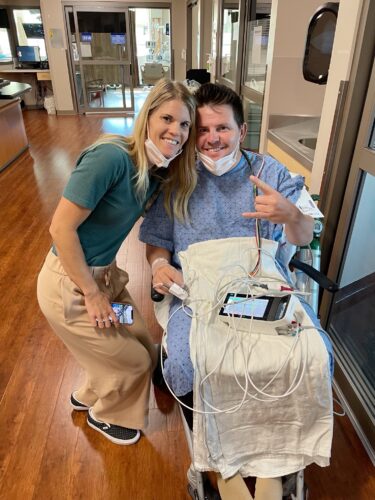Utah man’s stroke exemplifies uptick in younger patients

Courtesy of the Coleman family
Brad and Melissa Coleman at Intermountain McKay-Dee Hospital last October after Brad experienced a stroke.OGDEN — On the way to a soccer game last October, Brad Coleman started mumbling and slurring his words.
“He was just not making any sense,” said his wife, Melissa. “When we pulled up to a stop light, I looked over at him and the left side of his face was drooping. I said, ‘I think you’re having a stroke.’ He said, ‘No I’m not. I’m fine. Just keep driving.'”
Coleman, 36, had also suddenly lost strength on the left side of his body.
“I was in denial for a few minutes too because I thought, ‘How can he be having a stroke? He’s too young,” Melissa said.
Instead of taking him home, Melissa followed her instincts and drove her husband to an emergency clinic close by in North Ogden where it was confirmed Coleman was indeed having a stroke. After receiving a clot busting medicine, an ambulance was called and Coleman was rushed to Intermountain McKay-Dee Hospital where a mechanical thrombectomy was performed to remove the clot. It only took 13 minutes to get the clot removed from his brain from the time he entered the emergency department. Because of the swift action taken, Coleman’s symptoms were reversed.
McKay-Dee Hospital had been designated a Primary Stroke Center since 2007 and has performed hundreds of mechanical thrombectomies since 2011. However, the stroke program had recently gone through a rigorous and extensive certification by The Joint Commission and is the first nationally certified Thrombectomy-Capable Stroke Center in Utah.
Coleman isn’t the first young person to have a stroke in recent years. Dr. Melissa McDonald, stroke medical director and a neuro-hospitalist at McKay-Dee, said doctors have been seeing an increase in younger patients.
“Strokes don’t just happen to older people,” McDonald said. “We’ve seen an uptick in young people and some of that is probably related to COVID-19, but young people can have strokes for many reasons. Even kids have strokes.”
McDonald said one cause, which is extremely preventable, is cracking of the neck.
“Don’t crack your neck,” she said. “One of the things we see here too often is an artery dissection from someone’s neck being cracked.”
Infections, clotting disorders and cardiac problems can also contribute to strokes, McDonald said, and the biggest clue that you’re having a stroke is the sudden onset of symptoms.
“When a stroke is happening, you need to act fast,” said Dr. Michael Webb, an interventional radiologist at McKay-Dee.
The thrombectomy done on Coleman consisted of inserting a catheter in the hip area and guiding it up to the brain where the clot was sucked out, Webb said.
Once a clot is removed, blood is restored to the brain, which helps avoid cell death. But recovery is dependent on patients getting to a stroke center as quickly as possible to maximize the chance for a successful outcome.
“We have a saying in the stroke world: time is brain. A general rule of thumb is that 2 million neurons per minute can die during a stroke. That’s why it’s so important to be treated as quickly as possible,” Webb said. “We recommend patients call 911. EMS will take them to the most appropriate place, balancing distance with services offered. If that is not an option for patients, they should go to the nearest emergency department ASAP.”
The effects of a stroke depend on several factors including which part and how much of the brain is affected and how quickly the stroke is treated, he said.
Webb and McDonald said it takes a team effort to treat a stroke. Family and community members are considered to be part of that team.
“Brad didn’t realize he was having a stroke and that is pretty common when people are actually having one, so it’s really important that the people around them can recognize the signs and get them help as quickly as possible,” McDonald said.
Webb said receiving certification from The Joint Commission shows a measure of the commitment the institution has made to provide high-quality advanced stroke therapy.
“It’s taken a lot of time, practice and effort to get to this point where our program has met these standards to be recognized as a thrombectomy center,” he said.
Coleman said he is grateful to have been one of the first patients to be treated with the procedure.
“I didn’t know I was having a stroke,” he said. “But 30 minutes after that procedure, I didn’t have any problems. I had to stay in the ICU for 48 hours to be watched closely, but I feel like it never even happened.”
Coleman said it’s not clear what exactly caused his stroke, but he’s getting several tests done that will hopefully give some answers.
“I don’t know what caused it, but I did have a minor surgery the day before and stroke is always a risk after surgery,” he said. “But we still aren’t 100% sure. I am taking little precautions. I take an aspirin every day and I’m sure if I have surgery again, they’ll probably give me some medicine to prevent another stroke. But I feel grateful and I feel lucky to be alive.”
May is National Stroke Awareness Month. If you have any of these symptoms, get immediate help. Remember the BE FAST acronym:
- Balance — Loss of balance or coordination.
- Eyes — Changes in your vision.
- Face — One side of the face is drooping.
- Arm — Arm weakness, or weakness in any limb.
- Speech — Slurred speech or difficulty speaking.
- Time — Time is brain. Call 911.



